2017 Peugeot 308 brake
[x] Cancel search: brakePage 553 of 566
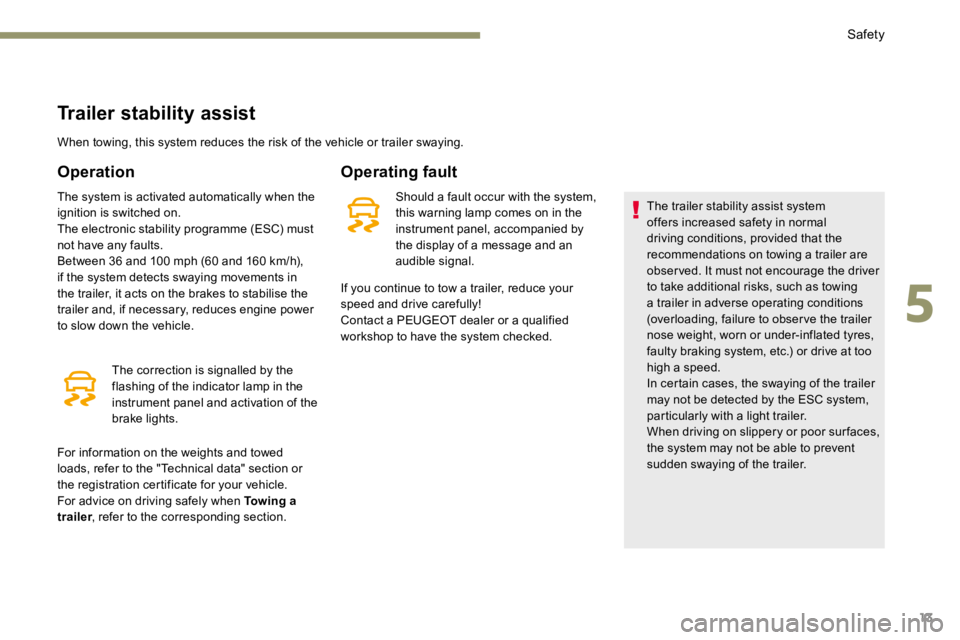
13
Trailer stability assist
When towing, this system reduces the risk of the vehicle or trailer swaying.
Operation
The system is activated automatically when the
ignition is switched on.
The electronic stability programme (ESC) must
not have any faults.
Between 36 and 100 mph (60 and 160 km/h),
if the system detects swaying movements in
the trailer, it acts on the brakes to stabilise the
trailer and, if necessary, reduces engine power
to slow down the vehicle.The correction is signalled by the
flashing of the indicator lamp in the
instrument panel and activation of the
brake lights.
Operating fault
Should a fault occur with the system,
this warning lamp comes on in the
instrument panel, accompanied by
the display of a message and an
audible signal. The trailer stability assist system
offers increased safety in normal
driving conditions, provided that the
recommendations on towing a trailer are
obser ved. It must not encourage the driver
to take additional risks, such as towing
a trailer in adverse operating conditions
(overloading, failure to obser ve the trailer
nose weight, worn or under-inflated tyres,
faulty braking system, etc.) or drive at too
high a speed.
In certain cases, the swaying of the trailer
may not be detected by the ESC system,
particularly with a light trailer.
When driving on slippery or poor sur faces,
the system may not be able to prevent
sudden swaying of the trailer.
If you continue to tow a trailer, reduce your
speed and drive carefully!
Contact a PEUGEOT dealer or a qualified
workshop to have the system checked.
For information on the weights and towed
loads, refer to the "Technical data" section or
the registration certificate for your vehicle.
For advice on driving safely when Towing a
trailer , refer to the corresponding section.
5
Safety
Page 554 of 566

14
Distance alert and Active Safety Brake
This system includes three functions:
- Distance alert (alert if there is a risk of
collision),
- Intelligent emergency braking assistance,
- Active Safety Brake (automatic emergency
b r ak ing).
Distance alert: it warns the driver if their
vehicle is at risk of collision with the vehicle in
front or a pedestrian present in their traffic lane.
Intelligent emergency braking assistance :
it supplements the braking action taken by the
driver if this is inadequate.
Active Safety Brake: it intervenes following
the alert if the driver does not react quickly
enough and does not operate the vehicle's
brakes.
If the driver fails to act, it contributes
towards avoiding a collision or limiting
its severity by reducing the speed of your
vehicle.
Activation and operating conditions
The vehicle has a camera located at the top of
the windscreen, and depending on the version,
a radar located in the front bumpers.
The system is activated from about 4 mph
(7 km/h) and is deactivated below about 3 mph
(5 km/h).
It takes account of:
- registered vehicles running in the same
direction or stationary,
- pedestrians in the traffic lane (bicycles,
motorcycles, animals and objects on the
road are not necessarily detected). This system is designed to assist the
driver and improve road safety.
It is the driver's responsibility to
continuously monitor the state of the
traffic, observing the driving regulations.
This system does not replace the need for
vigilance on the part of the driver.
Driving
Page 555 of 566
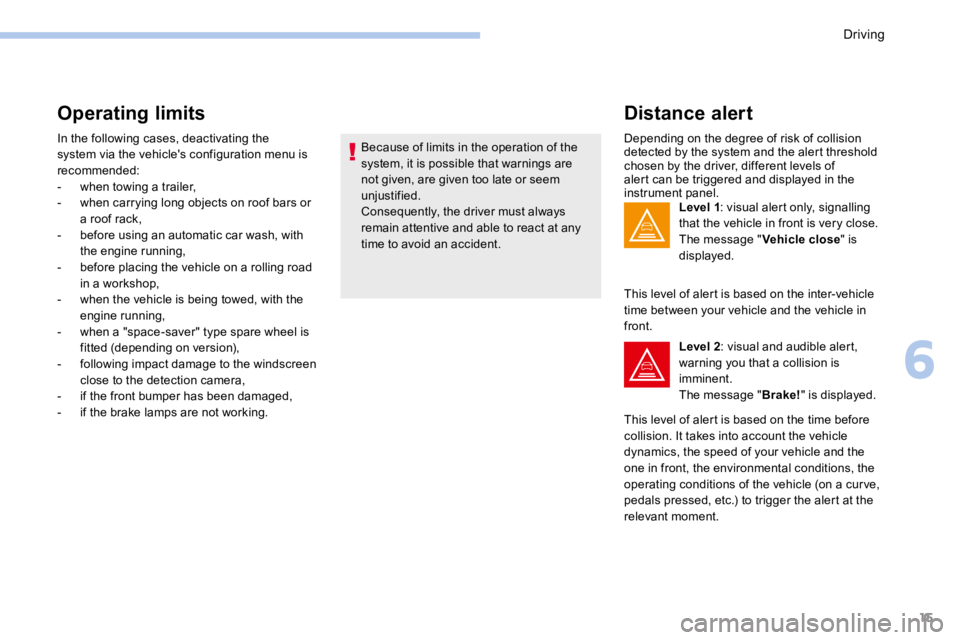
15
Operating limits
In the following cases, deactivating the
system via the vehicle's configuration menu is
recommended:
- when towing a trailer,
- when carrying long objects on roof bars or
a roof rack,
- before using an automatic car wash, with
the engine running,
- before placing the vehicle on a rolling road
in a workshop,
- when the vehicle is being towed, with the
engine running,
- when a "space-saver" type spare wheel is
fitted (depending on version),
- following impact damage to the windscreen
close to the detection camera,
- if the front bumper has been damaged,
- if the brake lamps are not working. Because of limits in the operation of the
system, it is possible that warnings are
not given, are given too late or seem
unjustified.
Consequently, the driver must always
remain attentive and able to react at any
time to avoid an accident.
Distance alert
Depending on the degree of risk of collision
detected by the system and the alert threshold
chosen by the driver, different levels of
alert can be triggered and displayed in the
instrument panel.
Level 1: visual alert only, signalling
that the vehicle in front is very close.
The message " Vehicle close" is
displayed.
This level of alert is based on the inter-vehicle
time between your vehicle and the vehicle in
front. Level 2: visual and audible alert,
warning you that a collision is
imminent.
The message " Brake!" is displayed.
This level of alert is based on the time before
collision. It takes into account the vehicle
dynamics, the speed of your vehicle and the
one in front, the environmental conditions, the
operating conditions of the vehicle (on a cur ve,
pedals pressed, etc.) to trigger the alert at the
relevant moment.
6
Driving
Page 556 of 566
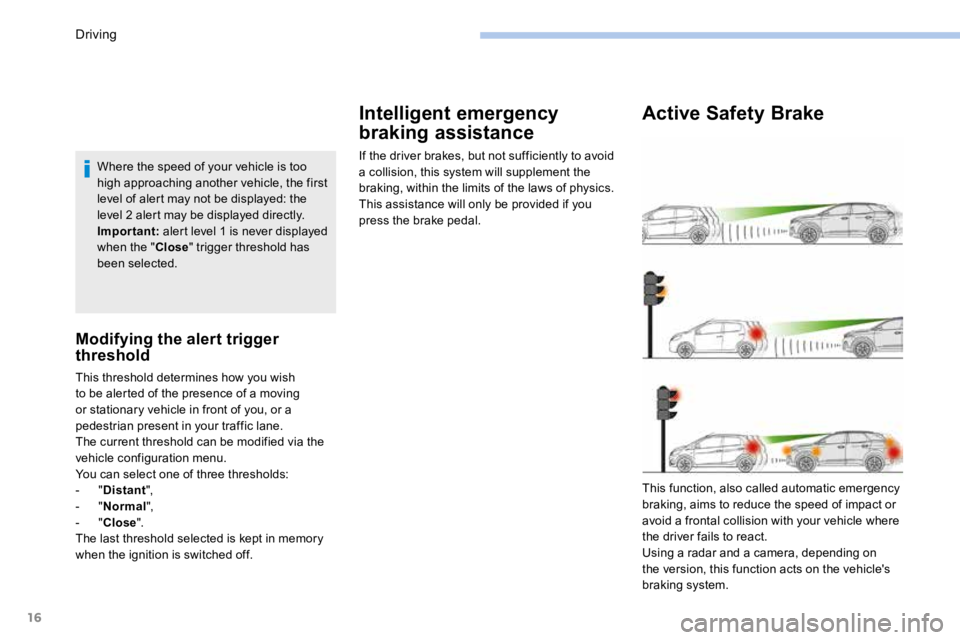
16
Where the speed of your vehicle is too
high approaching another vehicle, the first
level of alert may not be displayed: the
level 2 alert may be displayed directly.
Important: alert level 1 is never displayed
when the " Close" trigger threshold has
been selected.
Modifying the alert trigger
threshold
This threshold determines how you wish
to be alerted of the presence of a moving
or stationary vehicle in front of you, or a
pedestrian present in your traffic lane.
The current threshold can be modified via the
vehicle configuration menu.
You can select one of three thresholds:
- " Distant ",
- " Normal ",
- " Close ".
The last threshold selected is kept in memory
when the ignition is switched off.
Intelligent emergency
braking assistance
If the driver brakes, but not sufficiently to avoid
a collision, this system will supplement the
braking, within the limits of the laws of physics.
This assistance will only be provided if you
press the brake pedal.
Active Safety Brake
This function, also called automatic emergency
braking, aims to reduce the speed of impact or
avoid a frontal collision with your vehicle where
the driver fails to react.
Using a radar and a camera, depending on
the version, this function acts on the vehicle's
braking system.
Driving
Page 557 of 566
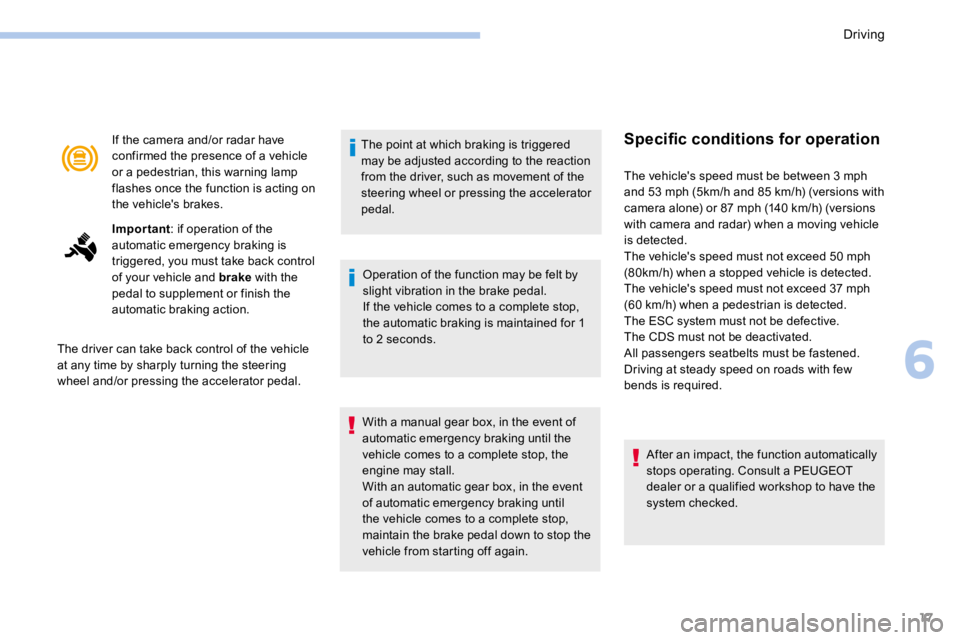
17
If the camera and/or radar have
confirmed the presence of a vehicle
or a pedestrian, this warning lamp
flashes once the function is acting on
the vehicle's brakes.
Important: if operation of the
automatic emergency braking is
triggered, you must take back control
of your vehicle and brake with the
pedal to supplement or finish the
automatic braking action.
The driver can take back control of the vehicle
at any time by sharply turning the steering
wheel and/or pressing the accelerator pedal. The point at which braking is triggered
may be adjusted according to the reaction
from the driver, such as movement of the
steering wheel or pressing the accelerator
pedal.
Operation of the function may be felt by
slight vibration in the brake pedal.
If the vehicle comes to a complete stop,
the automatic braking is maintained for 1
to 2 seconds.
With a manual gear box, in the event of
automatic emergency braking until the
vehicle comes to a complete stop, the
engine may stall.
With an automatic gear box, in the event
of automatic emergency braking until
the vehicle comes to a complete stop,
maintain the brake pedal down to stop the
vehicle from starting off again.Specific conditions for operation
The vehicle's speed must be between 3 mph
and 53 mph (5km/h and 85 km/h) (versions with
camera alone) or 87 mph (140 km/h) (versions
with camera and radar) when a moving vehicle
is detected.
The vehicle's speed must not exceed 50 mph
(80km/h) when a stopped vehicle is detected.
The vehicle's speed must not exceed 37 mph
(60 km/h) when a pedestrian is detected.
The ESC system must not be defective.
The CDS must not be deactivated.
All passengers seatbelts must be fastened.
Driving at steady speed on roads with few
bends is required. After an impact, the function automatically
stops operating. Consult a PEUGEOT
dealer or a qualified workshop to have the
system checked.
6
Driving
Page 560 of 566
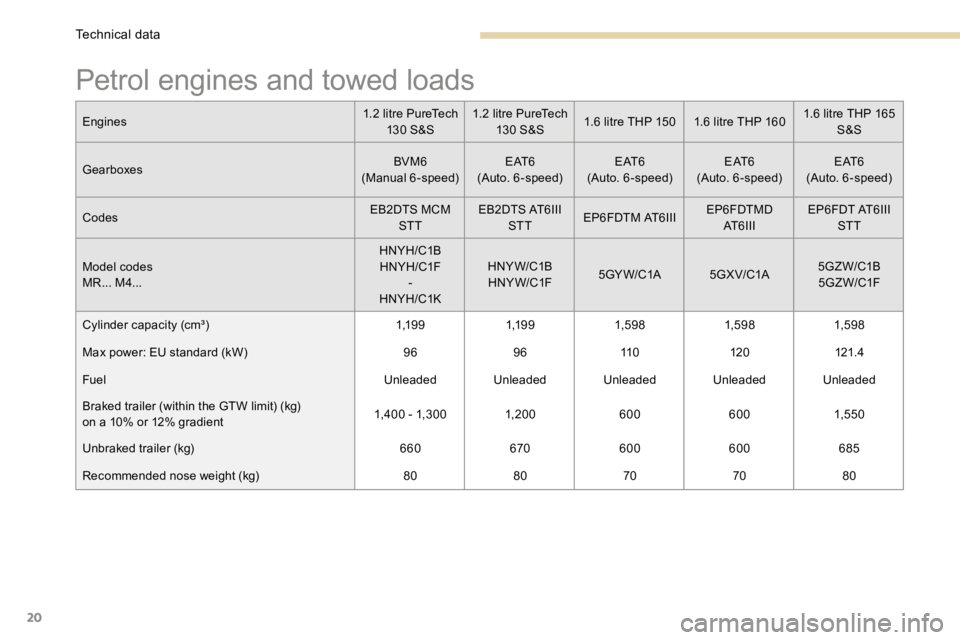
20
Petrol engines and towed loads
Engines1.2 litre PureTech
13 0 S &S 1.2 litre PureTech
13 0 S &S 1.6 litre THP 150
1.6 litre THP 160 1.6 litre THP 165
S&S
Gearboxes BVM6
(Manual 6-speed) E AT 6
(Auto. 6-speed) E AT 6
(Auto. 6-speed) E AT 6
(Auto. 6-speed) E AT 6
(Auto. 6-speed)
Codes EB2DTS MCM
STT EB2DTS AT6III
STT EP6FDTM AT6III EP6FDTMD
AT6III EP6FDT AT6III
STT
Model codes
MR... M4... HNYH/C1B
HNYH/C1F -
HNYH/C1K HNYW/C1B
HNYW/C1F 5GY W/C1A
5GX V/C1A5GZ W/C1B
5G Z W/C1F
Cylinder capacity (cm³) 1,1 9 91,1 9 91,59 8 1,59 81,59 8
Max power: EU standard (kW) 969611 0 120121.4
Fuel UnleadedUnleadedUnleadedUnleadedUnleaded
Braked trailer (within the GTW limit) (kg)
on a 10% or 12% gradient 1,4 0 0 - 1,3 0 0
1, 20 06006001,550
Unbraked trailer (kg) 660670600 600 685
Recommended nose weight (kg) 8080 707080
Technical data
Page 561 of 566
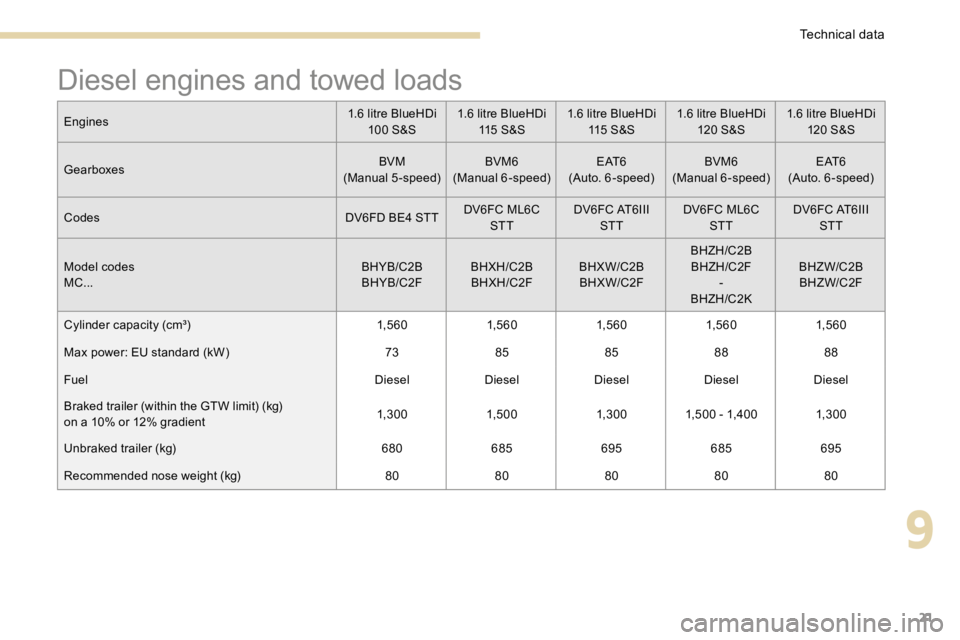
21
Diesel engines and towed loads
Engines1.6 litre BlueHDi
10 0 S&S 1.6 litre BlueHDi
115 S & S 1.6 litre BlueHDi
115 S & S 1.6 litre BlueHDi
120 S&S 1.6 litre BlueHDi
120 S&S
Gearboxes BVM
(Manual 5-speed) BVM6
(Manual 6-speed) E AT 6
(Auto. 6-speed) BVM6
(Manual 6-speed) E AT 6
(Auto. 6-speed)
Codes DV6FD BE4 STTDV6FC ML6C
STT DV6FC AT6III
STT DV6FC ML6C
STT DV6FC AT6III
STT
Model codes
MC... BHYB/C2B
BHYB/C2F BHXH/C2B
BHXH/C2F BHXW/C2B
BHXW/C2F BHZH/C2B
BHZH/C2F -
BHZH/C2K BHZW/C2B
BHZW/C2F
Cylinder capacity (cm³) 1,5 6 01,5 6 01,5 6 01,5 6 01,5 6 0
Max power: EU standard (kW) 7385 8588 88
Fuel DieselDieselDieselDieselDiesel
Braked trailer (within the GTW limit) (kg)
on a 10% or 12% gradient 1,3 0 0
1,5 0 01,3 0 01,5 0 0 - 1,4 0 0 1,3 0 0
Unbraked trailer (kg) 680685695685695
Recommended nose weight (kg) 8080808080
9
Technical data
Page 562 of 566
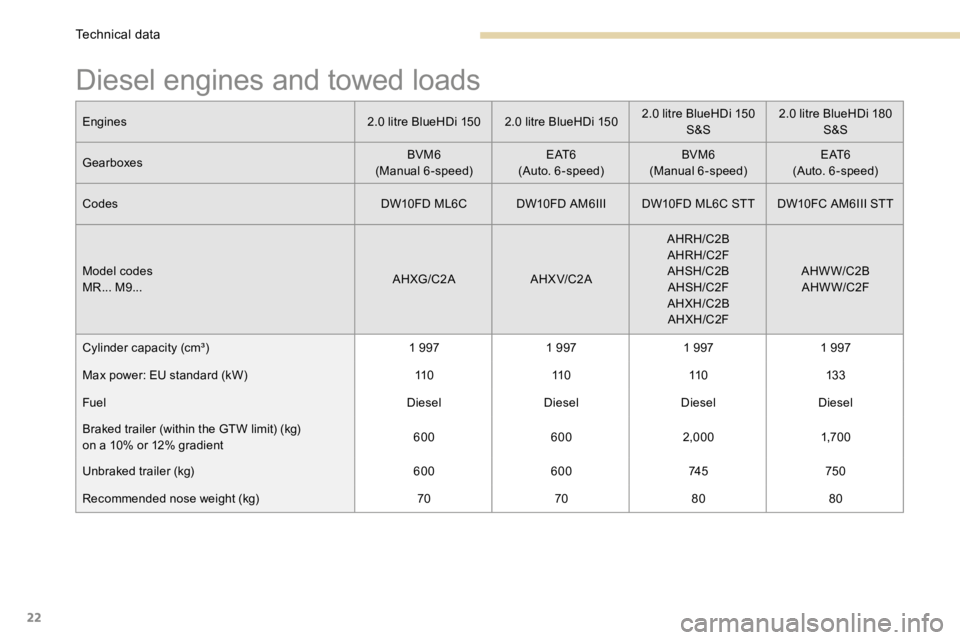
22
Diesel engines and towed loads
Engines2.0 litre BlueHDi 1502.0 litre BlueHDi 1502.0 litre BlueHDi 150
S&S 2.0 litre BlueHDi 180
S&S
Gearboxes BVM6
(Manual 6-speed) E AT 6
(Auto. 6-speed) BVM6
(Manual 6-speed) E AT 6
(Auto. 6-speed)
Codes DW10FD ML6CDW10FD AM6IIIDW10FD ML6C STT DW10FC AM6III STT
Model codes
MR... M9... AHXG/C2 A
AHX V/C2 AAHRH/C2B
AHRH/C2F
AHSH/C2B AHSH/C2F
AHXH/C2B AHXH/C2F AHWW/C2B
AHWW/C2F
Cylinder capacity (cm³) 1 9971 9971 9971 997
Max power: EU standard (kW) 11 011 011 013 3
Fuel DieselDieselDieselDiesel
Braked trailer (within the GTW limit) (kg)
on a 10% or 12% gradient 600
6002,000 1,70 0
Unbraked trailer (kg) 600600 74 5750
Recommended nose weight (kg) 707080 80
Technical data